Scientists built a “brain-computer”
Researchers created a computer that integrates electronics with real human brain tissue. Feng Guo, an engineer from Indiana University Bloomington, tested Brainoware with speech recognition and nonlinear equation prediction. It was slightly less accurate than a pure hardware AI computer, but Guo says it marks an important step in creating new computer architecture.
Many experts are racing to produce the most advanced artificial intelligence in the world, but we already possess it between our ears. The human brain outclasses every computer humanity has made, so researchers mimic it in developing new computers. Feng Guo and his colleagues may have broken ground by integrating human brain tissue into their new computer.
This article will discuss the Brainoware “brain-computer’s” creation and features. Later, I will cover other AI and computer innovations.
How does the brain-computer work?

Engineer Feng Guo and his colleagues started Brainoware development by taking human pluripotent stem cells and turning them into different brain cell types. Then, they organized the cells into mini-brains called organoids, complete with structures and connections.
ScienceAlert said these aren’t true brains. They are simple tissue arrangements without anything resembling emotion, consciousness, and thought.
Researchers integrated them into an array of high-density microelectrodes. It uses an artificial neural network type called reservoir computing.
The organoid serves as the reservoir where data will undergo processing. Electrical stimulation sends information to the organoid, processes the information, and then shares calculations as neural activity.
Feng Guo and his team tested the brain-computer by giving it 240 audio clips from eight male speakers making Japanese vowel sounds. Next, they commanded the bot to identify one specific individual’s voice.
They started with a fresh organoid. Then, they trained Brainoware for two days, and it was able to identify speakers with 78% accuracy.
The research team also asked the machine to predict a Hénon map, which is a dynamical system that exhibits chaotic behavior. The experts let it learn by itself for four days, with each day representing a training session.
You may also like: Brain chip lets people control devices with their minds
It was able to predict the map more accurately than an artificial intelligence network without a long short-term memory unit. However, Brainoware was less accurate than networks with long short-term memory units.
Still, those networks went through 50 training sessions. Conversely, Brainoware achieved similar results in less than 10% of the training time.
“Due to the high plasticity and adaptability of organoids, Brainoware has the flexibility to change and reorganize in response to electrical stimulation, highlighting its ability for adaptive reservoir computing,” the researchers wrote in their paper.
Similar AI innovations
Guo and his team created a brain-computer that thinks like a human, but what about one that moves like a person? Stanford and Facebook Artificial Intelligence Research (FAIR) labs have you covered!
They developed the Controllable Human-Object Interaction Synthesis or CHOIS. It enables AI systems to understand and mimic human movements based on text descriptions.
For example, let’s say you asked CHOIS to move a lamp closer to a sofa. Consequently, CHOIS will create a realistic animation of a human character picking up the lamp and putting it near the sofa.
You may also like: The Future of Cardiology: 3D Printed Heart Tissue
Another cool thing about the Stanford-Meta AI is its use of limited object waypoints to guide animations. These show where objects must move in a physically plausible way that follows a user’s input.
More importantly, the bot can correlate with spatial and physical actions. In other words, CHOIS understands picking up objects involves using your hands to grasp things.
CHOIS simulation also makes AI training more dynamic and fluid because you can watch your bot perform tasks in real-time. Moreover, you could tell it to do things differently if it fails.
Conclusion
Feng Guo created a computer that integrates with real human brain tissue. As a result, Brainoware generates comparable results to conventional hardware computers.
The researchers admit their brain-computer needs significantly more research and development to become a practical device. However, it could also provide more insights into the human brain.
Learn more about the Brainoware computer by reading its Nature Electronics article. Also, check out more digital tips and trends at Inquirer Tech.